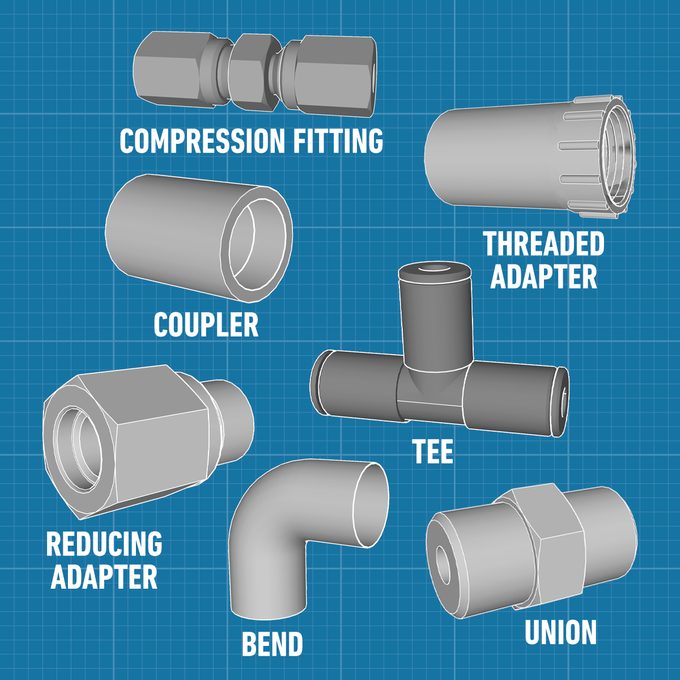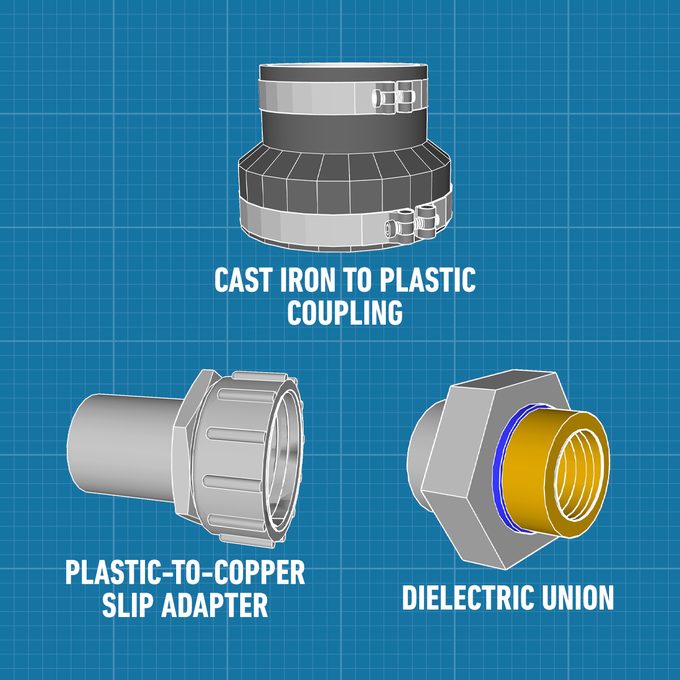I doubt there’s a DIY plumber out there who hasn’t experienced the frustration making multiple trips to the hardware store to complete a repair. I know I have.
Putting together a network of pipes of different diameters and materials can be like assembling a puzzle. Sometimes you don’t know exactly which fitting to buy until you reach the part of the puzzle where you need it.
Plumbing fittings vary by size, purpose and material. You often must tie together pipes of different materials with transition fittings. The materials in common use today — copper, PVC and CPVC, PEX, ABS, galvanized steel and cast iron — can mostly all be connected to each other with appropriate fittings.
With all the different pipe sizes and materials out there, things can get confusing. Fittings for water lines are different than those for drain and waste lines. It’s no wonder professional plumbers don’t go anywhere without a truck full of fittings. It’s their magic cupboard, letting them complete installations and repairs much more efficiently than amateurs like me.
Water Line Fittings
PEX is quickly becoming the material of choice for water lines. But PVC, CPVC and copper are still in common use, as is galvanized steel outdoors.
Three reasons for PEX’s popularity are its flexibility (it can bend around corners), durability and ease of assembly. You simply push PEX pipes and fittings together rather than gluing (PVC and CPVC), soldering (copper) or screwing them (galvanized steel).
Here are the fittings you’re most likely to need when assembling or repairing water lines:
- Coupler: Joins two lengths of pipe in a straight line. Whenever you cut a pipe during a repair, you’ll need a coupler to put it back together.
- Bend: For changing pipe direction. The most common bend angles are 90 degrees (aka elbows) and 45 degrees. Bends are typically made of the same material as the pipe except for PEX bends, which are brass or hard plastic.
- Tee: Shaped like the letter “T” with two parallel ports and a perpendicular one. It’s used for adding a branch line. When the branch line is a different size than the main one, you can make the connection with a reducing tee.
- Reducing adapter: Another way to join pipes of different diameters. It may be shaped like a bell (common for copper and galvanized pipes) or fit inside the larger pipe (more common for plastic). The first type is a bell adapter, and the second a reducing bushing.
- Union: A type of coupler you can take apart. Its large threaded nut holds together the two halves of the connected pipe. You can use one in place of a coupler in any situation where you temporarily disassemble the pipes.
- Threaded adapter: To join a pipe with a glue or solder slip joint to one with threads, you’ll need a threaded adapter. It can have male or female threads. Threaded adapters join plastic pipes to each other, or copper to itself or to brass.
- Compression fitting: This lets you join plastic or copper pipes without glue or solder. Most feature a ring that fits around the pipe and a nut that tightens onto the fitting, wedging the ring into the gap between the pipe and fitting. Compression fittings allow for easy pipe repair. Most modern faucet and toilet shutoff valves have compression fittings.

Waste and Drain Fittings
Cast iron was a common material for drain pipes in the first part of the 20th century. They’re usually connected with couplers that feature rubber gaskets surrounded by stainless steel sheathing.
These days, most drains are made with PVC or ABS plastic. Plastic drain fittings are usually glued, but the ones you might need to remove temporarily, like cleanout plugs, are threaded.
Here are the most common drain fittings. The list doesn’t include couplers and ordinary bends, because they’re similar to the ones used for water pipes and serve the same purposes.
- Long-sweep elbow: Makes a 90-degree bend in a longer arc than an ordinary elbow to allow water to flow more smoothly. It’s used for connecting vertical drain lines to horizontal ones.
- Straight tee: Performs the same function as tees for water lines, but are seldom used for drain lines. They’re mostly for vents, tying horizontal pipes to vertical stacks.
- Sanitary tee: Aka a santee, this has a sweep on its perpendicular port to promote water flow in the direction of the sweep. Use it to connect a horizontal waste line to a vertical one, but not a vertical one to a horizontal one. That’s the job of the next fitting.
- Wye: Shaped like the letter “Y,” a wye does the same job as a sanitary tee, but with less chance of backflow. This is the fitting you need to connect the vertical drain from your sink or toilet to the sewer. You can also use it to connect a horizontal waste pipe to a vertical one.
- Double wye: As you might expect, this has two inlet ports instead of just one. It’s commonly used for connecting a double-basin sink to a single P-trap.

Transition Fittings
Whether you’re connecting PVC or CPVC pipes to copper, cast iron pipes to ABS or galvanized pipes to copper, you’ll need a transition fitting. In some cases, you can do it by taking two threaded adapters of different materials and screwing them together. But it’s often easier to use an adapter specifically made to couple them, assuming you can find one.
- Plastic-to-copper slip adapter: This fitting has male copper threads on one end and a PVC or CPVC slip joint on the other. After soldering a female thread adapter to the copper pipe, you screw in the adapter and glue the plastic pipe to the slip joint.
- Dielectric union: Used for mating copper or brass to galvanized steel, its insulating washer keeps the pipes electrostatically separated to prevent corrosion. Dielectric unions are commonly used when installing water heaters.
- Cast iron to plastic coupling: These are widely known as Fernco couplings after the company that makes most of them. They consist of a rubber cylinder surrounded by a stainless steel sheath and two or more threaded pipe clamps tightened with a screwdriver.

Article source here: A Guide To Pipe Fittings and How To Use Them

No comments:
Post a Comment